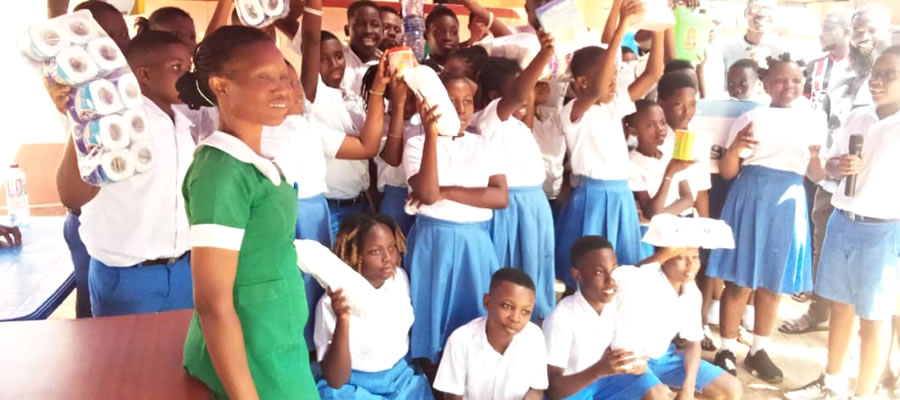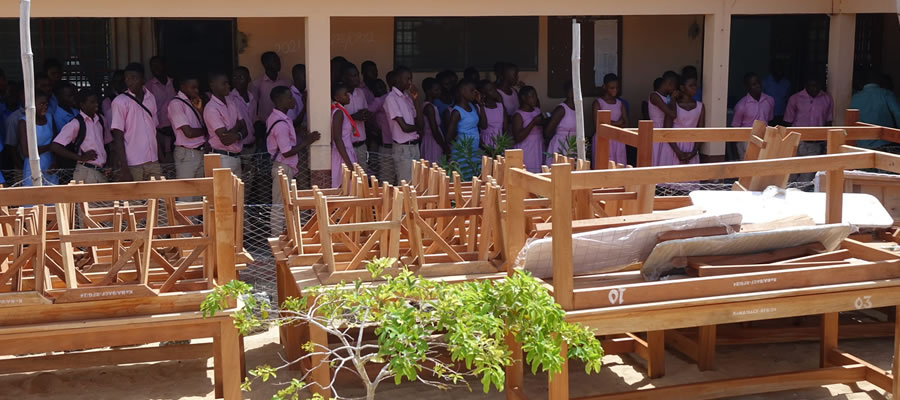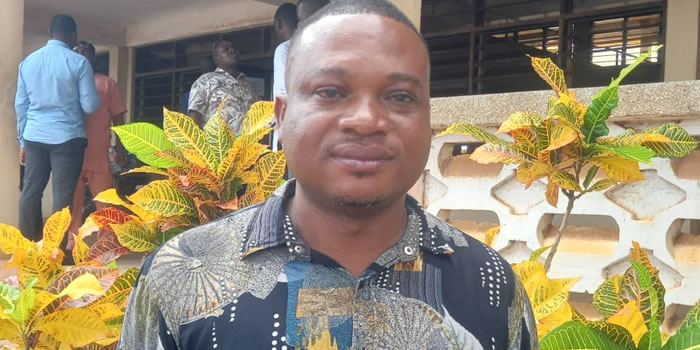

Population & Housing
The population of the District keeps on increasing despite the numerous accounts of emigration out of the District. However, the District’s position as a border area also contributed greatly to the increasing population. During the 2000 Population headcount, the district recorded a total population of 237.201. which constitute about 1-1.5% of the Regional population figure of 1.633.-121. Die District has therefore become the most densely populated district in the Volta Region. I he district has a population growth rate of 1.7%. By sex composition, females constitute 53.2% of" the total population with a sex ratio of 88.1%. Below is table and a bar showing the sex and age structure of the district’s population
The total population 47.5% are children below 18 years and 3.1% are adults above 75 years. Hence 50.6% of the populations are dependants.
By settlement only 7-1.8% of the population lives in the urban areas of Aflao (38,927) Dzodze (18, 957). Avoeme (7,251), klikor (6,856). Pernyi (5,403). and Agbozume (5.073) while 65.2% are found in 707 settlements. There are a total number of 10,086 houses in the 6 urban localities mentioned above with 19,594 households and having an average household size of 4.2. In all there are about 713 settlements in the district. With the population density of about 210 persons per square kilometer, land holdings are small especially in the farming communities. In addition, the heavy population in the district puts pressure on the existing social infrastructure. The Area Councils populations also give another dimension of the peculiarity of the district population distribution.
The natural Environment
The land in the district suffers from a lot of human activities, which degrade the environment. These activities include uncontrolled sand winning which is carried out particularly in Allan. Somey Hugo and We go sub-districts. Furthermore, annual bush fires occur especially between November and April. Another negative activity is the unbridled felling of trees for fuel, wood and other purposes. In view of the high incidence of tree felling, the forest Services Division has established a range at Denu. The service is also supporting the establishment of tree nurseries, woodlots and tree plantations by individuals and communities. The Denu Range has about 30.000 seedlings of Cassia. Acacia, leak, Mahogan, Eucalytus and Neem species. So far a total of 600ha of wood lots have been established in the district.
The Built Environment
Development of physical structures is of an unplanned fashion in the district as a result of the lack of the inadequate planning layouts to guide construction particularly in the urban centres. So far the Physical Planning Department had completed the layout for the Tokor. Aflao East awaiting presentation to the stakeholders before its implementation starts. The Dzodze Penyi Strategic Plan for the construction of Trans West African Highway has also been published. The major classes of land uses in the district include settlements, agriculture, infrastructure networks, wetlands, beaches and open waters. The few urban centres have other land uses like commerce, industry, Land management practices are generally very poor.
Human Settlement patterns : Infrastructure distribution and services level
The district exhibits both the rural and urban types of settlement but is largely rural. About 35% of populations live in a few urban centers (6) while the remaining 65% live in 707 rural settlements. By population distribution Aflao attracts as large as 38.927 people representing about 16% of the total district population (237261). In a scalogram analysis (figure) Aflao, Dzodze, Denu and Agbozume perform more than 10 functions each of the 30 services used for the analysis. Aflao had a total centrality index of 750, Denu, 778, Dzodze, 566 and Agbozume 468. Aflao, Dzodze, Denu and Agbozume therefore quality as the first order hierarchy settlements.
The situation may be explained in Aflao’s strategic location, as a border town and hence its influence to attract in-migrants and the polarization of investments and functions. Denu is the district capital, whiles Dzodze and Agbozume are commercial towns. Fifteen out of the selected settlements for the scalogram analysis perform less than 50% of the selected functions (5-1 7functions). The few (first and second order settlements) are functionally inefficient and economic social linkages are weak. I he implications are that there is a serious stress on the few facilities, poor access to services and hence a poor space economy.
The district’s spatial development focus should consider an integrated space economy by using the Urban/Town/Area council centers as nodes for development. .An attempt should be made to spread investments to settlement-, like Denu. Avoeme and Hedzranawo to redress the situation in Aflao. This strategy could also create a large market in the district.
Environmental assessment
Tools
Several programs and activities have been identified within the three pillars of the GPRS II for implementation in the mumicipal. It is clear from an assessment of some of the activities that their implementation will have some negative effects on other equally important programs and projects. As a prelude to the Program of Action (POA) for the 4 year time frame, an attempt has been made to come up with strategies and activities to mitigate some of the negative impacts that will result from the implementation of the programs.
Key Areas of concern for Poverty Reduction
The key areas identified for povcrlv which were used for the appraisal are: A Effects on natural resources. B) Effects on social and cultural conditions and C) Effects on the economy. Most of the activities appraised fully support the GPRS II. Their implementation will generate employment and improve the socio economic situation of the poor. Some of the programs however have negative implications for the environment and the people.
Performance of Individual PPPs
Some of the activities which fall within the Private Sector Competitiveness thematic area are the construction of markets, rehabilitation of selected feeder roads, construction of dams and dug outs and support to fishermen and processors, including fish smokers. It is anticipated that the implementation of these projects will promote economic activities, especially in the agricultural sector. It is however noted that their implementation will have negative impact on the physical environment. In the rehabilitation of roads for example, it will involve earth moving machines which will remove the topsoil and expose the land to serious erosion.
In the case of construction of markets, it should be noted that some of the markets like the l)/od/e market, which are now under construction have no provision for protection against lire. I’his could have serious implications for market users. Another activity under this pillar which could have negative impact on the health status of the people is the rehabilitation and construction of dams and dug outs lor farming purposes. Dams will definitely promote increased agricultural production. They could however become breeding grounds for mosquitoes. Malaria is one of the top ten diseases . I’he proliferation of dams could further worsen the malaria situation in the Municipality. Fish smokers rely heavily on wood from surrounding vegetation. The exploitation of lire-wood is seriously depleting the vegetative cover. One activity currentlv going on in the district which has serious impact on the physical environment is the production of cement at the Diamond Cement Factory at Aflao. This project is being carried out by a private investor. It is true that it is offering employment to several people. The environmental consequences, especially pollution of the atmosphere are dire.
Some of the activities which have positive impact on both the physical and socio economic environment are
A) Training of 100 farmers in each UTA Council in agro forestry
B)T rain 200 farmers in the construction of narrow cribs to prevent post harvest losses
C) Assist 20 communities to establish woodlots.
The implementation of these activities will preserve and regenerate the physical environment, while offering avenues for revenue generation.
Measures taken to improve performance
It is apparent that some measures need to be taken to contain the negative impact of some ol the activities listed above for implementation. In fact, some of the activities are either being implemented or have already been implemented. In order to overcome some of the negative effects identified during the appraisal, efforts are being made to collaborate with the relevant agencies and departments to plan strategics to confront them, for example, the fire Service has been contacted to advice on fire prevention and protection in the markets that are being constructed. Serious collaboration is also being forged with other relevant departments like MOFA. Forestry Commission and Environmental Protection Agency (EPA).
It has also been realized that activities such as the rehabilitation or construction of small dams must necessarily be carried out in view of their role in improving food production. Measures are however being put in place to embark on serious sensitization campaign to encourage the use of chemically treated mosquito nets in the catchment area of the dams. As a guarantee against the depiction of the topsoil and vegetative cover by contractors who undertake construction of roads, it has been decided to make it mandators for them to replant trees/grass along the road and also refill borrow pits used for winning gravel. This will be included in every bidding document.
The Way Forward
As an overall strategy, all the activities in the current MTDP have been subjected to Strategic Environmental Assessment and Compatibilily analysis. New donor programs like the CBRDP and the Millennium Challenge Account (MCA) are emphasizing environmental assessment as part of their implementation procedures. The CBRDP for example has provided funds for the training of beneficiaries of their projects including environmental issues. The MCA has also made it mandatory for all projects to be subjected to environmental assessment by Environmental Protection Agency (EPA)
Proposals for Monitoring Local Poverty Indicators
Most of the indicators have been identified and captured in the Project Planning Matrix (PPM) of the MTDP. These include income levels, levels of education, access to health care. education, water and sanitation facilities etc. Formats are being designed to enable the relevant agencies and departments compile monitoring reports which will be fed into a computerized system in the Assembly. The data will be constantly updated when feedback is received from the Held.
Opportunities for new activities
Some of the new activities have to do with waste recvcling, the salt indtistry and tourism promotion. The potential for salt production is particularly high along the coastal stretch between Adina and Blekusu. This tie into the Presidential Special Initiative on salt production. The same stretch also has wide sandy beaches which could be developed to tourist resorts. Under the implementation of the Millennium Challenge Account several dams and dug outs will be constructed in the municipality. This poses a new challenge for the management of environmental
Date Created : 11/21/2017 6:15:35 AM













 facebook
facebook
 twitter
twitter
 Youtube
Youtube
 +233 593 831 280
+233 593 831 280 0800 430 430
0800 430 430 GPS: GE-231-4383
GPS: GE-231-4383 info@ghanadistricts.com
info@ghanadistricts.com Box GP1044, Accra, Ghana
Box GP1044, Accra, Ghana